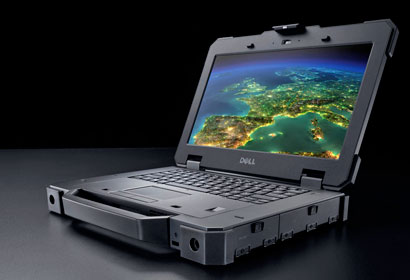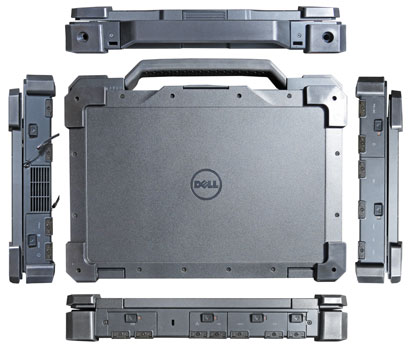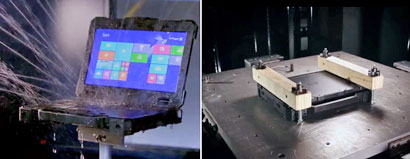|
Dell New Latitude 14 Rugged Extreme
Updated version of Dell's full-size, fully-rugged notebook computer packs a big punch
(by Conrad H. Blickenstorfer)
The Dell Latitude 14 Rugged Extreme was officially introduced on April 3, 2014, as a fully rugged notebook computer and successor to the impressive Dell Latitude E6420 XFR (see here). In Fall of 2016, Dell quietly introduced a significant technology update to their full-size rugged laptop, and simply called it the New Latitude 14 Rugged Extreme.

The challenge Dell's engineers faced when designing this machine was that its predecessor was already a very good and impressively rugged machine. The old XFR, however, was still using older Intel processor technology that generated a lot of heat, which resulted in performance drop-offs in high temperature testing and heavy draw on an undersized standard battery. So this was what Dell primarily had to work on.
And they did. On the processor side, the initial version of the platform used Intel "Haswell" 4th generation Core processors that provided in RuggedPCReview's testing (see here) very good performance with excellent power management. The "New" Latitude 12 Rugged Extreme skipped a processor generation and comes with a choice of three different Intel "Skylake" 6th generation Core processors.
With its heavy-duty construction and large display, this full-size Dell laptop tips the scale at just under eight pounds, battery included.
Display and interface
The big Dell has an 14-inch display with 1366 x 768 pixel resolution. That's a good chunk of screen real estate, without being too big. The resolution is the same as that of the smaller 12 Rugged Extreme. We wish there were a higher res option for applications that benefit from it, such as mapping and GIS, especially since Dell does offer a optional discrete AMD Radeon R7 M360 graphics card. Dell's civilian Latitude 14 does have a 1600 x 900 pixel display option, and we'd like to see that available for the rugged machine as well.
Dell is one of the pioneers in modern-era outdoor-viewable displays, and the 14 Extreme benefits from that expertise. Its latest Direct-View screen technology is designed to reduce internal reflectivity and display glare to the extent where the device doesn't need a battery-killing superbright backlight to achieve good viewing performance outdoors and in the sun.
Like many new notebooks that may run Windows 10, the Latitude 14 Rugged Extreme has a touchscreen. Dell chose resistive over capacitive multi-touch on the grounds that resistive technology works better with gloves and in wet conditions.
Extensive connectivity
Like the competition in this class, the Latitude 14 Rugged Extreme offers excellent connectivity and expandability. There are three USB 3.0 ports, another USB 2.0 port, two native RS232 serial port, two gigabit RJ45 LAN jacks, audio in/out, VGA and HDMI video, and a docking connector, all with protective covers. There is a memory card reader and an Expresscard/54 or PC Card slot, and unlike with the smaller convertible, they don't go at the expense of one of the three USB 3.0 ports). As can be seen in the bottom/side view composite picture below, all ports have protective covers.

Below a close-up of the Rugged Extreme models' protective door design. They securely snap into place, and can easily be exchanged should they ever break or wear out.

State-of-the-art wireless connectivity is crucial out in a mobile computing device, be it in the office or out there on the road or in the field. Dell covers that with an Intel Dual Band Wireless-AC 8260 module that also includes Bluetooth 4.2. Note that 802.11ac—the latest WiFi standard and often called "5G WiFi"—is up to three times faster than 802.11n. Optional mobile broadband is available via dual-band Dell Wireless 5808E Gobi 5000 4G LTE that also offers A-GPS.
Full ruggedness
How tough and rugged is the Dell rugged flagship? Very, as it should be carrying the "Extreme" label in its name. That includes IP65 sealing, where the "6" means it's totally dustproof and the "5" means it's also protected against low pressure water jets from all directions.
The device can operate within an extremely wide temperature range of -20° to 145° Fahrenheit (-29° to 63°Centigrade), which means practically anywhere.
Dell says the device is also independently tested according to MIL-STD-810G procedures for transit drop, blowing rain, blowing dust and sand, vibration, functional shock, freeze/thaw cycles, and more.
The pictures below illustrate some of the environmental testing Dell's new Rugged Extreme computers are subjected to:

Performance: Intel "Skylake" 6th gen Core processors
The "New" Latitude 14 Rugged Extreme skipped a processor generation compared to the original models and comes with a choice of three different Intel "Skylake" 6th generation Core processors. All three of the available CPUs are ultra-low voltage versions with TDPs of just 15 watts and integrated HD Graphics 520.
|
Available CPUs
|
Intel Core i7
|
Intel Core i5
|
Intel Core i3
|
|
Model
|
6600U
|
6300U
|
6100U
|
|
Cores/Threads
|
2/4
|
2/4
|
2/4
|
|
Base Clock Speed
|
2.60 GHz
|
2.40 GHz
|
2.30 GHz
|
|
Turbo Speed
|
3.40 GHz
|
3.00 GHz
|
No turbo
|
|
Thermal Design Power (TDP)
|
15 watts
|
15 watts
|
15 watts
|
|
Smart Cache
|
4MB
|
3MB
|
3MB
|
|
Integrated graphics
|
HD Graphics 520
|
HD Graphics 520
|
HD Graphics 520
|
|
Graphics base speed
|
300 MHz
|
300 MHz
|
300 MHz
|
|
Graphics max speed
|
1.05 GHz
|
1.00 GHz
|
1.00 GHz
|
|
Intel vPro
|
Yes
|
Yes
|
No
|
To see full spec table for these three CPUs, see here.
The device supports up to 16GB of DDR4 memory in two slots. Mass storage is via mSATA solid state disks up to 1TB. An SED version (Self-Encrypting Drive) is optionally available. The 14 Rugged comes standard with a 65 watt-hour Li-Ion battery, and there's an optional 97 watt-hour battery good for up to 13 hours.
Keyboard: Full scale and RGB backlight
The full-size keyboard of the Latitude 14 Rugged Extreme has a crisp and clean layout with well designed labels. A special RGB backlight allows users to set the keyboard backlight to any color they wish. That can come in very handy.
Security
For security, the Dell Latitude 14 Rugged Extreme has FIPS 140-2 TPM 2.0 functionality to store secured information. Smart Card reader and optional fingerprint reader provide additional access security. There's a cable lock slot, some of the available processors support vPro, a set of Intel security and remote management technologies that offer multiple lines of built-in defenses, and there are also Dell's advanced security and data protection and encryption tools.
What Dell brings to the table
The big difference between Dell and its competition in the rugged space is that Dell is also a world-leading provider of commercial PCs, which gives them an edge in large scale production experience and also enterprises that like to one-stop shop. Between that, Dell's solid commitment to the rugged space, and the machine's impressive design, up-to-date technology and specs, this new fully rugged notebook is certain to be a strong competitor.
Customers still using the old Dell XFR will find in the Latitude 14 Rugged Extreme a machine that's not only somewhat lighter without compromising on ruggedness, but also one that offers better battery life while still outperforming the XFR. Those already familiar with the original Latitude 14 Rugged Extreme will find the upgraded "new" version significantly more powerful.
|



